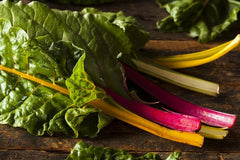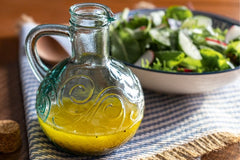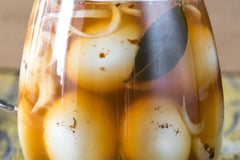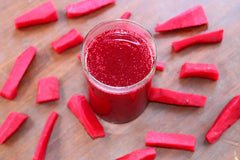How To Make Kimchi

Kimchi, the fermented vegetable dish that is currently busy taking over the world, is a delicious Korean side you can easily make at home. So let’s explore the fascinating world of kimchi, shall we? We want you to know everything there is to know about kimchi – from its origins and the traditional way of making it to kimchi varieties, a step by step guide that will teach you how to make it, and a recipe that will help you prepare the most delicious homemade kimchi.
What Is Kimchi?
For the Western World, kimchi is the Korean version of sauerkraut. It’s made with Napa cabbage, a few other vegetables, and some spices to give the dish a little bit of heat and extra flavor. Kimchi is so good it’s addicting. However, unlike other addictions, kimchi is actually good for you. Like sauerkraut, kimchi is a fermented dish that’s very good for gut health. But more about the health benefits in a bit. For now, we think it’s important to know a little bit more about the history of this popular Korean dish.
Kimchi History and Origins
Kimchi originated in Korea centuries ago. Back in the day, when there were no refrigerators and freezers to help preserve food and, of course, no supermarkets with an endless supply of fresh veggies, people relied on preservation methods to have food supplies during winter months. That’s how many of our favorite fermented foods came to life. Kimchi is obviously no exception.
As you can imagine, the kimchi recipe suffered many modifications during its long history. Initially, kimchi was made just with cabbage and salt. Then, when chili peppers arrived in Korea, kimchi developed its spicy flair for which it is renowned today. Soon after, other veggies and seasonings were added to the mix.
Since kimchi is such a culinary staple in Korean cuisine, every family has its own unique recipe. Koreans like to prepare kimchi in their own kitchens and they are very particular about the flavors. Each family prefers distinctive kimchi, therefore recipes are usually passed down from the old generations to the new generation.
It seems like Koreans cannot really live without kimchi and, if you ever tasted the spicy, savory and sharp dish, you know why - kimchi is too good not to fall in love with it.
The popularity of kimchi spread beyond the Korean borders once tourists and raw food enthusiasts discovered it. Nowadays, the Western world seems to be just as obsessed with kimchi as Koreans are. Ok, maybe not just as obsessed but close. And we’re pretty sure the popularity of kimchi will continue to grow and more and more people will love it. Seriously, once you try it, it’s hard not to crave it time and time again.
Before we talk about the nutritional profile of kimchi, we have to mention that kimchi is not limited to cabbage. Kimchi is versatile and it can be made with many different veggies. In fact, the word “kimchi” is the Korean term for fermented veggies so pretty much anything edible can be turned into kimchi.
Nutritional Value of Kimchi
According to health magazine, Health.com, kimchi is one of the healthiest foods in the world. Kimchi is not only nutritious but it also has many health benefits. The fermented dish contains approximately 50% of the recommended amount of carotene and vitamin C. It’s also high in fiber and low in calories so you can include it in your diet without feeling guilty.
Eating kimchi promotes healthy digestion, boosts the immune system, helps prevent the growth of cancer cells, and combats harmful bacteria. All thanks to the nutrients found in cabbage and the lactic acid bacteria that develop during the fermentation process.
How To Make Kimchi Step By Step Guide
While kimchi takes from a few days to a few weeks to ferment, making kimchi takes less than 30 minutes of hands-on time. After that, Mother Nature will take over and transform cabbage into delicious kimchi.
Before we discuss the steps of making kimchi in detail, let’s see what are the basic ingredients for the dish. For classic kimchi, you need:
- Napa cabbage;
- Salt;
- Water;
- Radish;
- Scallion;
- Red pepper flakes (gochugaru);
- Ginger;
- Garlic;
- Sugar.
You can make delicious kimchi using only the ingredients we listed above. However, kimchi is versatile so you can substitute ingredients and spices to make it exactly how you like it. Our favorite kimchi recipe is at the end of this post but, if you follow the steps below, you’ll be able to personalize your kimchi as you want.
Prep The Cabbage
Cabbage is typically the main ingredient in kimchi but you can make kimchi with radishes and cucumbers too. When you make kimchi, the first step is always prepping the main ingredient. So, if you’re using cabbage, chop it into 2-inch strips. Then transfer the cabbage to a bowl, salt it, and add water until the cabbage is fully submerged. Place a heavy plate or a lid with something heavy on top over the cabbage and let sit for at least two hours.
Prep The Rest of the Ingredients
After the cabbage is prepped, you can peel, chop, and grate the rest of the veggies. Add these over the cabbage.
Make The Kimchi Paste
Typically, kimchi paste is made of ginger, red pepper flakes, garlic, sugar, and some type of liquid. We like our kimchi paste with seafood flavor but you can use fish sauce instead. If you want a vegan or vegetarian kimchi, use water. All you have to do is to mix all these ingredients together and the kimchi paste is ready.
Mix It All Together
Mix all the ingredients together. You want to massage the kimchi paste into the cabbage so don’t be afraid to use your hands. If you use red pepper flakes in your kimchi, glove your hands first because the oil produced by the pepper flakes, especially if you’re using gochugaru, can sting your hands.
Fermentation Process
You can ferment kimchi once or twice. If you want to shorten the preparation process, follow the steps in our kimchi recipe. They’ll show you exactly what you have to do. If you use our method, you’ll have to wait a little longer for kimchi to be ready but we promise you the dish is worth the wait.
If you want to ferment the cabbage twice, after you prepped the cabbage, let it sit at room temperature for 24 hours. When ready, drain the cabbage but make sure you keep the salty brine. Pack the cabbage to the jar and use the reserved brine to fill the jar until the cabbage is covered with liquid. We really recommend using our Easy Fermenter Lids and our Fermenting Weights for an easier fermentation process. But, if you cannot wait to make kimchi and you don’t have our fermenting tools yet, you can use a cabbage leaf to keep the kimchi submerged in the liquid and a simple lid to seal the jar.
How Long Does It Take To Ferment Kimchi?
Some say kimchi is ready in just one or two days. Others say one or two weeks. It’s up to you, really. You can ferment kimchi for anywhere from one day to two weeks. Kimchi is ready when the cabbage is still crisp but with a tangy and slightly sour flavor. Taste it every few days to see if kimchi reached your desired sourness. When it tastes perfect to you, move the kimchi jar to the fridge to slow down the fermentation process.
How to Store Kimchi
Do you have to refrigerate kimchi? During the fermentation process, no, you don’t have to refrigerate it. Although you can if the room temperature in your house is higher than 70 degrees F. However, once the kimchi is done fermenting and you opened the jar, refrigerating it is a must since the flavor of kimchi will continue to develop at room temperature.
In the fridge, you can store the kimchi for up to three weeks. Kimchi doesn’t really go bad but it ripens so the flavor becomes sourer with time.
Kimchi Varieties
Kimchi might’ve been created as a way to preserve veggies for winter months but what started as cabbage pickled in a salty brine transformed over the years into the delicious kimchi we all know and love today through the addition of varies spices and seasonings.
As we previously mentioned, kimchi doesn’t refer exclusively to pickled cabbage. There are many other kimchi varieties you can enjoy if you visit South Korea or if you follow our basic step-by-step guide to make them at home.
Baechu Kimchi
Baechu kimchi is the most popular kimchi variety in South Korea. This kimchi is made with whole salted cabbage mixed with fish sauce, chili powder, and garlic.
Kkakdugi Kimchi
Kkakdugi kimchi is made with the same seasonings and spices as baechu kimchi, however, the main ingredient is radish, not cabbage.
Nabak Kimchi
Nabak kimchi is made with radishes and cabbage. Moreover, the recipe also requires sliced fruits, such as pears or apples. The addition of fruits makes this kimchi sweeter than the other varieties.
Yeolmu-kimchi: Young Summer Radish Kimchi
Yeolmu kimchi is what most Koreans enjoy during summer months when cabbage is not ready for harvest yet. To make it, you need summer radishes, green onions, Korean chili powder, and chives.
Oi-so-bagi Aka Cucumber Kimchi
Oi-so-bagi is another kimchi variety that’s ideal during summer months. It’s made with cucumbers, it has a crunchy texture, and is a very refreshing variation of kimchi.
How to Use Kimchi
Kimchi is a healthy and nutritional powerhouse you can enjoy guilt-free any time of the day. You can enjoy it on its own, paired with Asian style foods or as a side dish.
You can add kimchi to:
- Burgers;
- Korean style tacos;
- Wraps;
- Grilled cheese sandwiches;
- Quesadillas;
- Scrambled eggs;
- Tofu scrambles;
- Stir-fried rice.
Kimchi Recipe
This kimchi recipe will help you put together a flavorful and delicious kimchi that will be loved by everybody. If you want a vegetarian or vegan option, replace the seafood flavor in the recipe with water or ¾ teaspoon of kelp powder mixed with 3 tablespoons of water.
Ingredients:
- 1 Medium head Napa cabbage (2 pounds);
- 1/4 cup unrefined sea salt;
- Filtered water;
- 5 or 6 garlic cloves;
- 1 tablespoon ginger;
- 1 tablespoon sugar;
- 3 tablespoon seafood flavor (optional – you can use water if you don’t have or don’t like seafood flavor);
- 1 to 5 tablespoon gochugaru – Korean red pepper flakes (you can use cayenne pepper flakes if you don’t have gochugaru);
- 8 ounces Korean radish or daikon;
- 4 scallions.
- Knife;
- Kitchen grater;
- Large mixing bowl;
- Small mixing bowl;
- Plate;
- Rubber gloves;
- Mason Jar;
- Easy Fermenter Lids (not required)
- Fermenting Weights (not required)
Instructions:
- Peel and grate the garlic and the ginger.
- Peel and cut the Korean radish or daikon into matchsticks.
- Trim and cut the scallions into 1-inch pieces.
- Cut the cabbage into quarters lengthwise. Remove the cores and cut each quarter crosswise into 2-inch strips.
- Place the cabbage strips into a mixing bowl.
- Add salt and mix together thoroughly. Add water to cover the cabbage then place a plate on top of the cabbage. Weigh down the plate with something heavy to keep the cabbage submerged under the water.
- Let stand for 1-2 hours.
- After 1-2 hours, rinse the cabbage under cold water. Drain and set aside in a large bowl.
- In a small mixing bowl, combine the garlic, ginger, sugar, red pepper flakes, and seafood flavor (or water if you opted for water), and mix until you form a paste.
- Add the radish, scallions, and the paste you just made over the cabbage in the large bowl. Glove your hands and mix everything together.
- Transfer the mixture to the mason jar. Leave 1-inch headspace.
- Cover the jar with the Easy Fermenter Lid and place the Fermentation Weights in the jar to ensure perfect fermentation results.
- Store the mason jar at room temperature (ideally 60-70 degrees F) in a dark place for 1-2 weeks, until it reaches your desired taste.
Want To Take Your Fermenting To the Next Level?
Enroll in our Fermenting Mastery Video Series. A complete set of detailed, step-by-step instructions that will give you the confidence to create ferments that you’re proud of, every single time. Even when you make up your own recipes and techniques! Included are 14 professionally recorded recipes - Over two hours of content to help you master your ferments.









